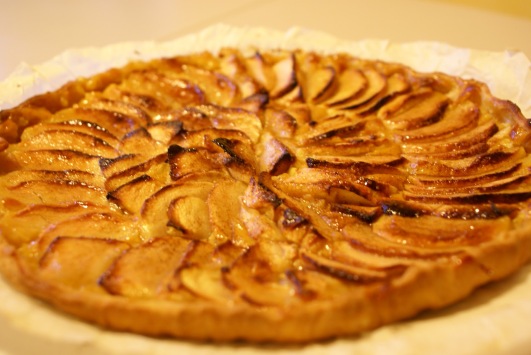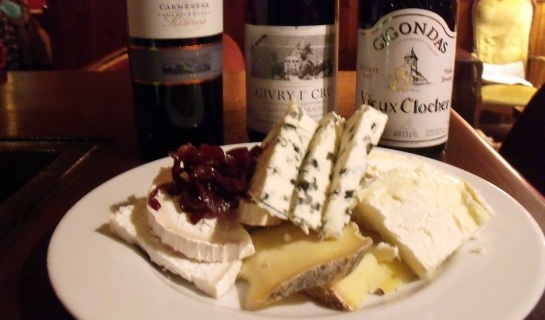“Husband à l’Etranger” has been repatriated this autumn after many years of working internationally and as you can imagine this necessitated a measure of celebration on the home front, as well as enjoying the rare opportunity to get together with friends and especially our very dear neighbours who are always ready to come to the rescue in moments of need with pots of cream, bags of emmenthal râpé and cups of sugar.
Yesterday the perfect moment arrived to “fête” our friendship which started not long after we bought our house – a jolly conversation from balcony to street in which we discovered two of our children had been in the same lycée class for a brief moment in time.
All that was missing from this pre-Christmas bit of fun was the venue. But it didn’t take long to resolve that minor issue. Our neighbours had a friend staying who suggested we all went to try ‘Le Canard Rouennaise’ at the smart Hotel de Dieppe a few minutes walk from our home.
The ceremony behind Rouen duck is quite an experience. Prepared in the dining room in front of the diners it is not for those of delicate disposition, the cracking of bones and extraction of blood being only part of the visual experience. But this is France and the French are renowned for their ability to eat the most extraordinary ingredients and products that are gruesome enough to make your toes curl.
So what of this extraordinary duck? The breed itself is the product of the amorous relations between the migrating wild ducks taking a brief “séjour” in the cliffs above the river Seine at Duclair and local farmyard ducks they spotted from overhead. The resultant canette is medium sized, big breasted, small thighed, blood rich and succulent, and waddling about the farmyard was historically the perfect bird to spit roast in the event of the arrival of an impromptu guest. Not having time to bleed the duck, this impromptu meal necessitated the suffocating of the bird before roasting it on a spit for twenty minutes over a wood fire. The breast was served with a sauce rich in blood, liver and bone marrow.
Inevitably in order to protect the recipe, the “Ordre des Canardiers” was founded, and the confection of the Canard Rouennaise rests on the fundamental premise that the duck be a “true Rouennaise duck”, suffocated and not bled, the commercialisation of which is permissible under the title “exception culturelle”. The breast must be removed, spit roasted for 17-20 minutes and served with a sauce made with the pressed extraction of its own blood.
Ultimately one such duck was presented to King Edward the Seventh by the maître Chef Louis Convert of the cruise liner Félix Faure, and it is this recipe, recreated in 1933 by the chef Michel Guéret who was his young intendant, which the “Ordre des Canardiers” present today as the authentic.
Within minutes of being seated at our table a silver mobile preparation table was wheeled into view. The bird, recently having undergone its spit-roast was relieved of its carcass in front of us before its bones were ceremoniously carved into pieces small enough to fit the enormous silver press. The loud cracking of bones must be imagined as an essential part of the process.

 The “Maître Canardier”, complete with blue ribboned medal around his neck, set to with aplomb the process of extracting the blood and bone marrow into a waiting gravy-boat by authoritatively turning the enormous wheel of the press.
The “Maître Canardier”, complete with blue ribboned medal around his neck, set to with aplomb the process of extracting the blood and bone marrow into a waiting gravy-boat by authoritatively turning the enormous wheel of the press.

 The secret base of the sauce, a confection of duck liver , “vin de Beaune” and spices was brought into the dining room, which Monsieur Le Canardier flambéed with a glass of cognac before adding the extracted blood, 20 grammes of pure Normandy butter, lemon juice and a glass of port.
The secret base of the sauce, a confection of duck liver , “vin de Beaune” and spices was brought into the dining room, which Monsieur Le Canardier flambéed with a glass of cognac before adding the extracted blood, 20 grammes of pure Normandy butter, lemon juice and a glass of port. After the great excitement of the preparation, there was only one thing left to do… déguster! (Taste!)
After the great excitement of the preparation, there was only one thing left to do… déguster! (Taste!) The copious breast meat of the “Rouennaise Ducks” was quickly polished off. It wasn’t long however before the men at the table noticed that for three birds there was scant thigh or wing meat. At 50€ a head the conversation soon fell to the subject of the “canard perdu”- or the lost duck.
The copious breast meat of the “Rouennaise Ducks” was quickly polished off. It wasn’t long however before the men at the table noticed that for three birds there was scant thigh or wing meat. At 50€ a head the conversation soon fell to the subject of the “canard perdu”- or the lost duck.
As we poured uproariously out of the restaurant into the frosty misty night, we were still searching for the “canard perdu” all the way home! Bon appétit!
Bon appétit!



 The cluster of buildings, so typical of the rural Normandy countryside are built with timber frame, twisted with age, and the daub, local clay dug from the local area, with little hairline cracks that formed as it shrunk and dried in situ.
The cluster of buildings, so typical of the rural Normandy countryside are built with timber frame, twisted with age, and the daub, local clay dug from the local area, with little hairline cracks that formed as it shrunk and dried in situ.

 The owners demonstrated the amazing capabilities of their sheep-dogs, who believe it or not are bilingual. When two dogs herd the sheep at the same time, the first is communicated to in french whilst the second responds to english in order that their commands are not confused. Today mother dog acted swiftly to “gauche, gauche, gauche, avance, se couche, à pied “(left left left, advance, lie down, heel), while daughter dog watched on with obvious envy, having firmly been told this time to “sit”.
The owners demonstrated the amazing capabilities of their sheep-dogs, who believe it or not are bilingual. When two dogs herd the sheep at the same time, the first is communicated to in french whilst the second responds to english in order that their commands are not confused. Today mother dog acted swiftly to “gauche, gauche, gauche, avance, se couche, à pied “(left left left, advance, lie down, heel), while daughter dog watched on with obvious envy, having firmly been told this time to “sit”.
























 See you there!
See you there!







